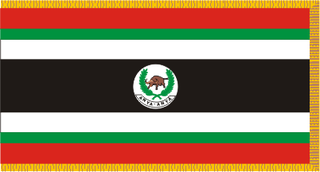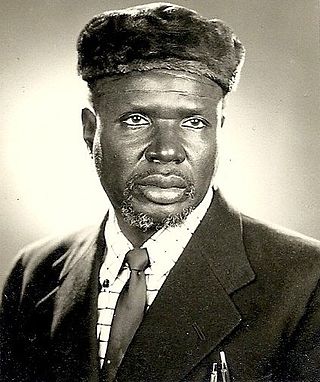Related Research Articles

Equatoria is the southernmost region of South Sudan, along the upper reaches of the White Nile and the border between South Sudan and Uganda. Juba, the national capital and the largest city in South Sudan, is located in Equatoria. Originally a province of Anglo-Egyptian Sudan, it also contained most of northern parts of present-day Uganda, including Lake Albert and West Nile. It was an idealistic effort to create a model state in the interior of Africa that never consisted of more than a handful of adventurers and soldiers in isolated outposts.

The Addis Ababa Agreement, also known as the Addis Ababa Accord, was a set of compromises within a 1972 treaty that ended the First Sudanese Civil War (1955–1972) fighting in Sudan. The Addis Ababa accords were incorporated in the Constitution of Sudan.

Dr. John Garang De Mabior was a Sudanese politician and revolutionary leader. From 1983 to 2005, he led the Sudan People's Liberation Army/Movement as a commander in chief during the Second Sudanese Civil War. He briefly served as First Vice President of Sudan for three weeks, from the comprehensive peace agreement of 2005 until his death in a helicopter crash on July 30, 2005. A developmental economist by profession, Garang was one of the major influences on the movement that led to the foundation of South Sudan’s independence from the rule of Sudanese president Omar al-Bashir.

The South Sudan Liberation Movement (SSLM) is an armed group that operates in the Upper Nile Region of South Sudan. The group's creation was announced in November 1999 by people of the Nuer ethnicity who were in both the rebel Sudan People's Liberation Army (SPLA) and the government-allied South Sudan Defence Forces (SSDF) gathered in Waat. The SSLM was declared to be unaligned in the Second Sudanese Civil War, then entering its sixteenth year. The name "South Sudan Liberation Movement" was decided upon the next year, borrowing from the earlier Southern Sudan Liberation Movement, which existed in the 1980s.

The First Sudanese Civil War was a conflict from 1955 to 1972 between the northern part of Sudan and the southern Sudan region that demanded representation and more regional autonomy. The war was divided into four major stages: initial guerrilla warfare, the creation of the Anyanya insurgency, political strife within the government and establishment of the South Sudan Liberation Movement. Around a million people died over the course of the nearly 17-year long war.

The Anyanya were a southern Sudanese separatist rebel army formed during the First Sudanese Civil War (1955–1972). A separate movement that rose during the Second Sudanese Civil War were, in turn, called Anyanya II. Anyanya means "snake venom" in the Ma'di language.

The Sudan People's Liberation Movement is a political party in South Sudan. It was initially founded as the political wing of the Sudan People's Liberation Army in 1983. On January 9, 2005 the SPLA, the SPLM and the Government of Sudan signed the Comprehensive Peace Agreement, ending the civil war. SPLM then obtained representation in the Government of Sudan, and was the main constituent of the Government of the then semi-autonomous Southern Sudan. When South Sudan became a sovereign state on 9 July 2011, SPLM became the ruling party of the new republic. SPLM branches in Sudan separated themselves from SPLM, forming the Sudan People's Liberation Movement–North. Further factionalism appeared as a result of the 2013–2014 South Sudanese Civil War, with President Salva Kiir leading the SPLM-Juba and former Vice President Riek Machar leading the Sudan People's Liberation Movement-in-Opposition.

Joseph Lagu is a South Sudanese military figure and politician. He belongs to the Madi ethnic group of Eastern Equatoria, South Sudan.

The SPLA-Nasir was a splinter faction of the Sudan People's Liberation Army (SPLA), a rebel group that fought in the Second Sudanese Civil War. Originally created as an attempt by the Nuer tribe to replace SPLA leader John Garang in August 1991, it gradually became coopted by the government. The break away of Riek Machar from SPLM/A resulted in Nuer ethnic group massacring Garang's ethnic Dinka from Bor in the Bor massacre in 1991. This split resulted in the 1994 National Convention of New Sudan in Chukudum.
Anyanya II is the name taken in 1978 by a group of the 64 tribes of South Sudan dissidents who took up arms in All of Sudan. The name implies continuity with the Anyanya, or Anya-Nya, movement of the First Sudanese Civil War (1955-1972).

Lt Gen Dominic Dim Deng was a senior member of the Sudan People's Liberation Army, a distinguished military veteran general and the first defence minister in the Government of Southern Sudan who lost his life alongside his wife Madam Josephine Apieu Jenaro Aken, senior politician Dr. Justin Yac Arop and 18 other Sudan People's Liberation Army and Government of Southern Sudan officials on a leased CEM Air Beechcraft 1900 that crashed 375 km west of Juba, Sudan on May 2, 2008.

The South Sudan People's Defence Forces (SSPDF), formerly the Sudan People's Liberation Army (SPLA), is the army of the Republic of South Sudan. The SPLA was founded as a guerrilla movement against the government of Sudan in 1983 and was a key participant of the Second Sudanese Civil War, led by John Garang. After Garang's death in 2005, Salva Kiir was named the SPLA's new Commander-in-Chief. As of 2010, the SPLA was divided into divisions of 10,000–14,000 soldiers.
Clement Wani Konga is a Mundari leader who fought in the Anyanya independence movement in the south of Sudan in 1969−72. He then joined the army of Sudan and rose to the rank of major general. In 2004 he made peace with the Sudan People's Liberation Movement (SPLM) and was appointed interim governor of Central Equatoria in South Sudan. In August 2015 he was dismissed from his post by president Salva Kiir Mayardit. He continued to be active as chairperson of the Mundari Community.
Joseph Oduho Haworu was a leading politician from southern Sudan who was active in the struggle for independence and a founding member of the Sudan People's Liberation Movement (SPLM).

The Gambela People's Liberation Movement was a rebel group in the Gambela Region in Ethiopia. The GPLM was founded by Anuak dissidents during the Derg and Woyane regime. The organization remained dominated by Anuaks. Agwa Alemu was the chairman of the GPLM.

Gordon Muortat Mayen Maborjok (1922–2008) was a Sudanese revolutionary and politician and advocate for Southern Sudan's independence. He was the President of the Nile Provisional Government (NPG) which led the Anyanya during the First Sudanese Civil War. Muortat also served as Vice-President of the Southern Front (SF) and Foreign Minister in the Southern Sudan Provisional Government (SSPG).

Grass Curtain was a quarterly journal of Southern Sudanese politics and current events published by the Southern Sudan Association in London between 1970 and 1972. Enoch Mading de Garang was the journal's co-founder and editor-in-chief. The Grass Curtain was closely linked to the Southern Sudan Liberation Movement (SSLM), the political arm of Anya-Nya, a collection of Southern Sudanese separatist movements formed during the First Sudanese Civil War. The journal was published in large part to generate wider support for the South Sudanese cause.

Oliver Batali Albino was a South Sudanese politician and civil servant.

The South Sudan Opposition Alliance is a coalition of political parties and armed groups in South Sudan that opposed the government of President Salva Kiir. It was formed in February 2018 in Addis Ababa, Ethiopia, by nine groups. In September the alliance acceded to a revised peace deal with the government that also included the main rebel faction, the Sudan People's Liberation Movement-in-Opposition, but some of the member groups disagreed with the decision and split from the alliance. The pro-deal SSOA has experienced continued tension between its members, as well as with the government.
References
- 1 2 "Finding Guide for Martin and Margo Russell (Durham University Library, Archives and Special Collections, Sudan Collection, GB-0033-SAD)". reed.dur.ac.uk. Durham University Library. 2015. Retrieved June 19, 2017.
- ↑ "Brian MacDermot (Art Obituaries)". the Telegraph. London. October 18, 2013. Retrieved June 20, 2017.
- 1 2 3 Kramer, Robert S.; Andrew Lobban, Richard; Fluehr-Lobban, Carolyn, eds. (2013). "Southern Sudan Association". Historical Dictionary of the Sudan. Rowman & Littlefield. p. 395. ISBN 978-0810861800.
- ↑ Poggo, Scopas S. (2009). The First Sudanese Civil War: Africans, Arabs, and Israelis in the Southern Sudan, 1955-1972 . New York: Palgrave Macmillan. pp. 64, 128–130.
- ↑ Akol, Jacob J. (2005). I Will Go the Distance: The Story of a "lost" Sudanese Boy of the Sixties. Nairobi, Kenya: Paulines Publications Africa. p. 287. ISBN 9966080619.
- 1 2 3 4 Kuyok, Kuyok Abol (2015). South Sudan: The Notable Firsts. AuthorHouse. ISBN 9781504943444.
- 1 2 Pirouet, M. Louise (1976). "The Achievement of Peace in Sudan". Journal of Eastern African Research & Development. 6 (1): 115–145.
- ↑ Abdel Ghaffar Mohamed Ahmad (2010). Sudan Peace Agreements: Current Challenges and Future Prospects (PDF) (Report).
- ↑ Tounsel, Christopher Gallien (2015). 'God will crown us': The Construction of Religious Nationalism in Southern Sudan, 1898-2011 (PDF) (PhD dissertation (History)). University of Michigan.